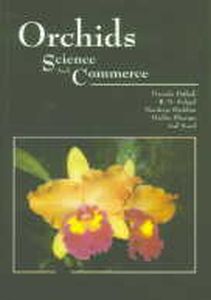
Contents: Foreword. Introduction. Preface. 1. Professor S.P. Vij and his work/Promila Pathak. 2. John Lindley (1799-1865) and his role in orchid science: the great teacher and researcher/H.F. Oakeley. 3. Orchids: the world’s most wondrous plants/Suman Kumaria and Pramod Tandon. 4. William Griffith and his Bhutanese Vanda species/Phillip Cribb, Nicholas Pearce and Yeshey Dorji. 5. Orchid diversity in India: an overview/D.K. Singh. 6. Morphological diversity of the orchids of Orissa/Sarat Misra. 7. A conspectus of orchids of Manipur: their status and conservation/A.S. Chauhan. 8. Orchids of Sikkim – a historical perspective/C. Sathish Kumar. 9. Phylogenetic evolution of the genus Calanthe/Genjiro Ishida and Kohji Karasawa. 10. Morphological variations in the genus Stelis/Kamezo Saito. 11. Investigation on ploidy of Cymbidium, Dendrobium, and Phalaenopsis cultivated in Japan using flow cytometer/Syoichi Ichihashi, Hiroshi Ito, Tatuya Oguri, and Juntaro Kato. 12. Cytospeciation and diversification in Indian orchids/Navdeep Shekhar, R.N. Sehgal and Neera Vaidya. 13. The inheritance of Albinism in Dendrobium orchids/Montakan Vajrabhaya and Thavorn Vajrabhaya. 14. Apercu Sur L’ovaire Des Orchidaceae De L’ Anthese A La Maturite (in French)/Yvonne Veyret. 15. A survey of the ovary of Orchidaceae from Anthesis to its maturity (in English)/Yvonne Veyret. 16. The orchid Pollinarium – its development and ultrastructure/Veena Gupta and M.R. Vijayaraghavan. 17. The microtubular cytoskeleton during ovule and embryo development in orchids/E.C. Yeung, X.L. Ye and S.Y. Zee. 18. In Vitro propagation as an aid to conservation and commercialization of Indian orchids: seed culture/Promila Pathak, K.C. Mahant and Ashish Gupta. 19. In Vitro multiplication of orchids/Devinder Prakash and M.L. Chaudhary. 20. Species seedling flasks: an urgent need for Ex Situ conservation and sustainable economic utilization of the Western Ghats orchids/S. Seeni, A. Gangaprasad and S. William Decruse. 21. Orchid cryopreservation by using induced shoot Primordia and Protocorm – like bodies of tissue culture/Katsuhiko Kondo, Irina V. Tatarenko, Sindhu Balu Varghese, Yuji Iwai and Ken-ichiro Matsumoto. 22. Molecular approaches to orchid improvement/P.C. Deka and J. Devi. 23. Micropropagation and Agrobacterium – mediated gene transformation of orchids/Yoshiyuki Niimi, Takahisa Hatano and Lie Chen. 24. Viral diseases of orchids and their management/Padma Ramachandran and Anupam Varma. 25. Commercialization of Indian orchids/P.S. Ahuja, Madhu Sharma and Anil Sood. 26. Cymbidiums of North-Eastern Himalayas/R.C. Upadhyaya and S.P. Das. 27. Plant tissue culture research and its commercialization in India/Suman Govil and Shrish C. Gupta. 28. Orchid commerce in India – guidelines for the new century/Udai C. Pradhan. Subject index.
From the preface : "The orchids are a group of extremely interesting plants which outnumber all the other plant groups in the Plant Kingdom. Numbering about 20,000 species, they exhibit pollination-related floral complexities, produce a large number of microscopic, and poorly organized seeds, and require a fungal endophyte (mycorrhiza) for their germination and growth in nature. The morphological, physiological, and genetic peculiarities inherent in this group of plants have stimulated research to such a degree that Orchidology today is one of the most popular and dynamic branches of Botany.
The orchids represent aristocracy in floriculture; their acquisition and display has now become a status symbol. The amenability of these plants to hybridization and the ease with which hybrid genotypes can be rescued through biotechnological means, adds a new dimension to their marketability in the international trade in cut-flowers and pot-plants. Rich in alkaloid and other phytochemicals, the orchids have a therapeutic value; what is more, they are being extensively used in the indigenous system of medicine for a host of ailments.
The orchids are well represented in India as a whole, but they are not predominant anywhere in the country. Nearly 1,200 species in 165 genera have been authenticated till date and their number is likely to go higher still as several areas in the major orchid-rich belts (Himalayan, North-East Indian, and Peninsular regions) are yet to botanically explored. Many of them, particularly in genera Aerides, Arachnis, Cattleya, Cymbidium, Dendrobium, Epidendrum, Oncidium, Paphiopedilum, Phalaenopsis, Renanthera, Vanda, etc., have been extensively used to progenate high profile and internationally acclaimed hybrids. The Indian orchids are paradoxically victims of their own beauty and popularity; the result is that their natural population is rapidly declining because of unbridled commercial exploitation on the one hand and deterioration of their habitats on the other. More than 150 species are thus in danger of becoming extinct while some others like Calanthe pachystalix, C. whiteana, Coelogyne albolutea, C. assamica, and Paphiopedilum charlesworthii, have already become so."